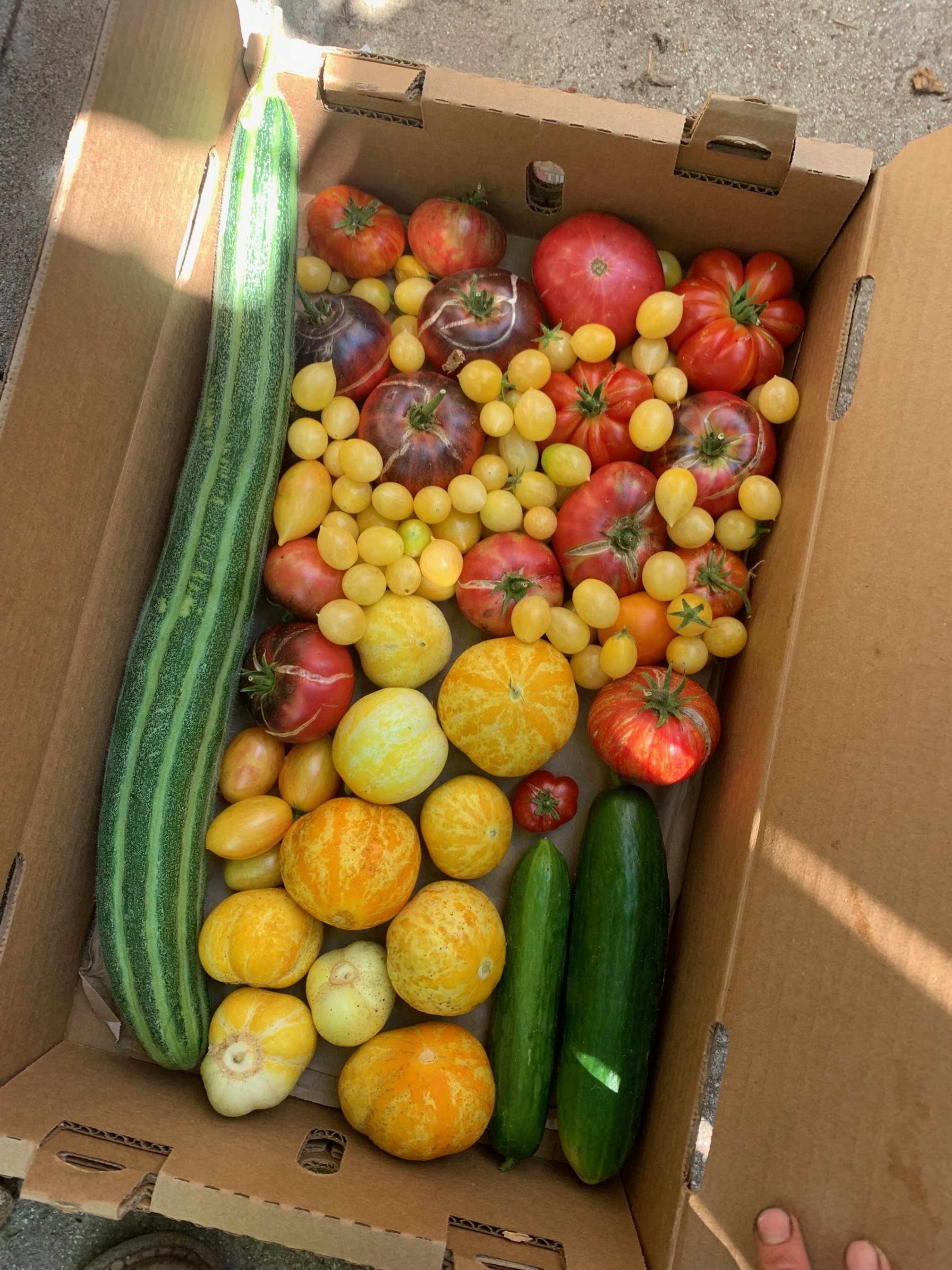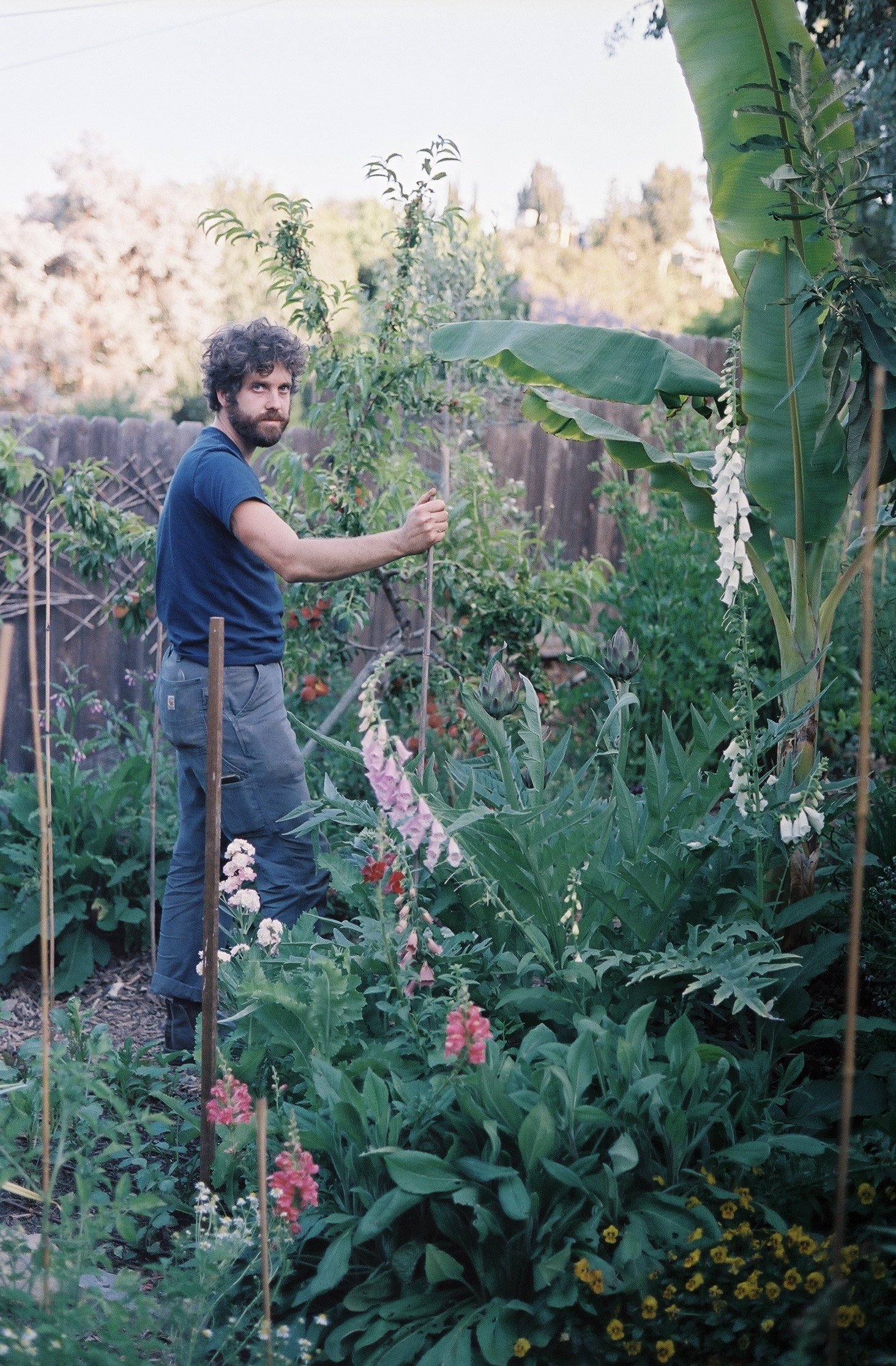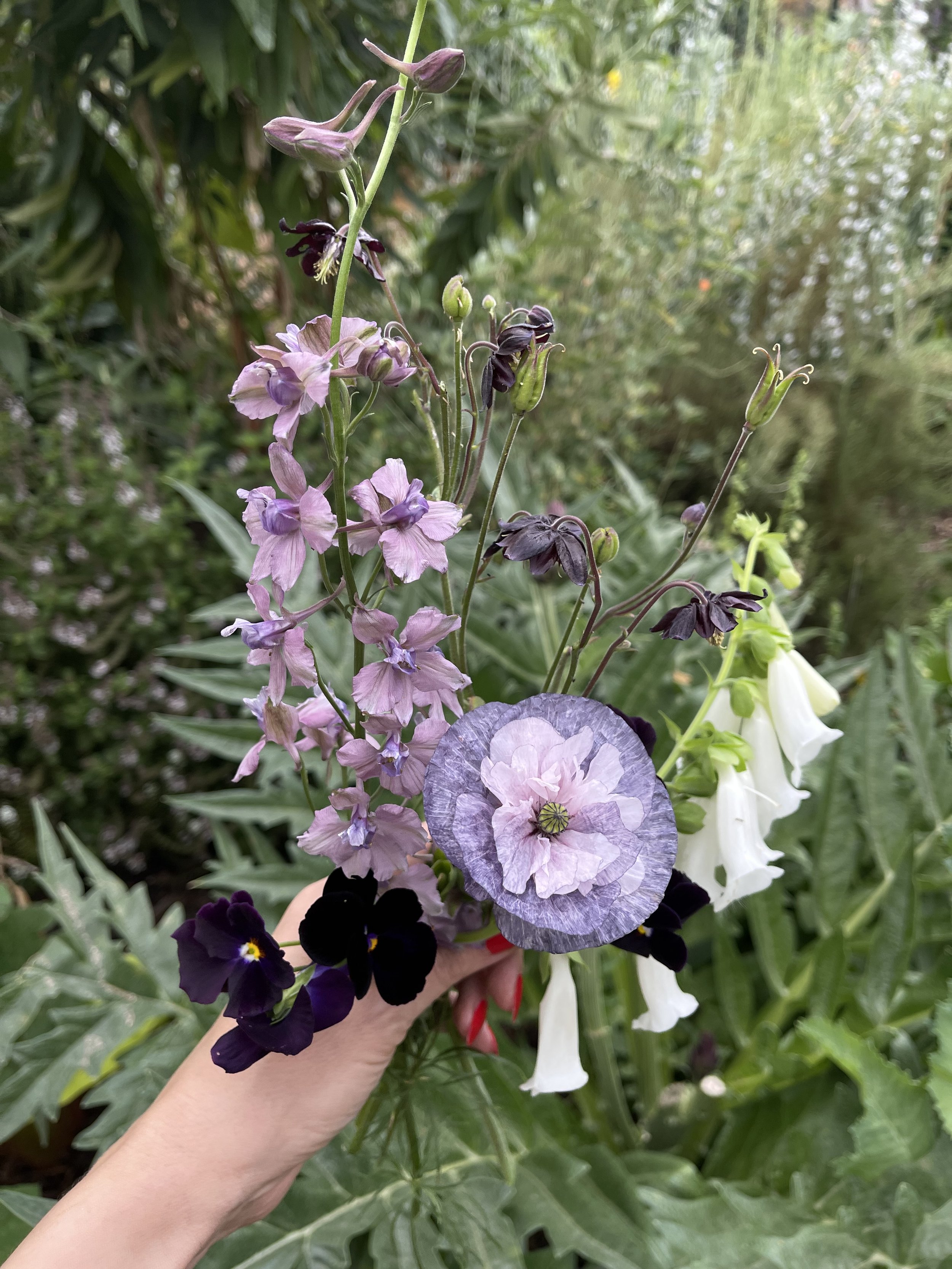Yasmine Khatib & Horace Cameron
September 13, 2022
Yasmine Khatib, a florist, and her partner Horace Cameron, a gardener, have built their lives around plants. Her primary focus is flowers, his food. They share a great passion for the beautiful things one can coax from the dirt: paper-thin cosmos, curling lettuces, jewel-like currants. Yasmine’s arrangements often include edible elements, some of which Horace has grown especially for her. Flowers are an integral part of his gardening philosophy, incorporated both to entice pollinators and enchant humans. Their garden in Los Angeles bursts with color and flavor. Together Yasmine and Horace live in the space where the plants we ogle and those we eat commingle. I love this collision of plants’ purpose. Cultivating flowers can seem frivolous when compared with the practical, urgent business of growing food. But the blooms we find so attractive have evolved to be seductive to the insects that aid in their reproduction — there is a functionality to their allure. We are entangled in a symbiotic relationship with plants and seduction is a crucial part of the dynamic. Horace and Yasmine help me remember and marvel at the interconnectedness of beauty and survival.
One photo below particularly encapsulates Yasmine and Horace dreamy botanical collaboration: a spray of traveler’s tomatoes, a variety that bunches in grape-like clusters, perched atop a green velvet pedestal. The fruit was grown by Horace and arranged, like a Dutch Masters still life, by Yasmine. That tomatoes stand in for the flowers you’d expect is surprising; the effect is both whimsical and also moving. The traditional art historical context (dramatic light, sumptuous tableau) interrupted by a funky tomato, of all things, invites us to reconsider our inherited aesthetic values. Those tulips you’d more often see in elegant, elevated repose are made of the same dirt and sunlight as the stuff we eat for lunch. I love that, in Yasmine and Horace’s universe, the difference between practical plants and pleasure plants has collapsed. We are nourished by them all in turn.
Horace and Yasmine in their garden
A collaborative arrangement (Horace’s tomatoes, Yasmine’s touch)
Georgia Hilmer: How would you describe each of your jobs? What’s the best part of the work you do?
Yasmine Khatib: I am a florist, so my job consists of arranging flowers, fruits, and fungi. The best part of my work is getting to marvel at the beauty of the natural world on a daily basis. It never gets old.
Horace Cameron: I am first and foremost a culinary gardener, with interests in cut flowers and native plants, also drought tolerant plants from around the world. I set up culinary gardens for clients and maintain them. This is a more recent career switch for me. I was a bartender for over nine years and gardening was just a hobby previously. I really love being outside, seeing the birds, insects, lizards, clouds, trees, learning all the time. It’s neverending in my eyes.
GH: How did you two meet? Did plants play a role?
YK: Horace and I spoke for the first time one night when I happened to see him at a restaurant in our neighborhood. I had to make the first move, as we had lived five blocks away from each other for six years and he never once approached me. On our first date, he gave me a jar of green beans he had pickled and the rest is history.
HC: We would see each other in the neighborhood, on and off, but we never spoke to each other. One evening, I was sitting at a bar restaurant, reading, and she was sitting next to me at the bar with her friend and she turned and asked me, “Who are you? I see you everywhere.”
GH: What kind of community have you built around flowers and gardening?
HC: I’m a little bit more of a solo/lone-wolf type when it comes to the gardening world thus far. I spend almost all my time gardening alone. It’s actually really important for me: time to reconnect and listen to my thoughts or forget my thoughts. That being said, I have made many friends through the plant/edible gardening world of Instagram — three friends who I can say have really influenced the way I garden to this day.
GH: What’s growing in your garden right now? Have you had any particular gardening triumphs or failures lately?
HC: Currently I am growing a lot of tomatoes (Barry’s Crazy Cherry, Blue Beauty, Traveler’s Tomato, Blush, Ceylon, Red Currant, Afghan, to name a few), cucumbers (Lemon, Cucamelon, Persian and Striped Serpent, which is actually a muskmelon), peppers (Padron, Haskorea, Petit Marseillais, Criolla di Cochina, Nardello, Diavolicchi), zinnias, cosmos, dahlias, agastaches, mountain mint, nepitella, purslane, scabiosa, gravillea, pincushion, squash, cucuzza, passionfruit, African blue basil, rudbeckia, goldenberry, Phoenician mullein, rosemary, lemongrass, stinging nettle, mint, hollyhock, oregano, amaranth, four huge cannabis plants, Crandall’s black currant, eggplants, bronze fennel, rose geranium, lemon verbena, basils, roselle, okra, kale, turmeric, melons, raspberries, boysenberries, three grapes (Thomcord, Flame, Muscat of Alexandria) and the list just keeps going and going.
I’ve put in a lot of fruit trees: Medlar, four figs (Panache, Flanders, Honey, Violette de Bordeaux), two apples (Ashmead’s Kernal, Golden Nugget), a peach, Satsuma plum, ice cream banana, three persimmons (Fuyu, Hachiya, Lilac), almond, citrus (Chinotto, Santa Teresa Feminello Lemon, Eureka Lemon, Variegated Pink Lemon), two olive trees (Arbequina, Nocellara del Belice) and Jaboticaba.
We have this Buddleja Globosa, two until recently, that has grown from eight inches to eight feet or larger that just hasn’t produced any flowers. They are a flower Yasmine uses a lot and comes down to us from Oregon. Though it grows well here, it must need more chill hours to produce flowers. It is from Chile originally. I am about to potentially take out the last plant, even though it adds a nice texture to the garden.
This year I planted two types of currants. It was a gamble. According to CRFG (California Rare Fruit Growers) currants should only be an experimental endeavor in Southern California. I planted Primus White and Crandall Black. Primus White did not produce any fruit. It in fact barely got going after it’s dormancy phase. I just ripped them out. They looked pretty sad. Crandall did so well, even produced a lot of fruit in this first year, although I wonder if it got its chill hours from where it came from. It’s still growing, foliage is looking healthy and I have hopes for the following years.
GH: Do you have early plant memories or encounters that have shaped your relationship to the natural world?
YK: I come from a family of plant lovers, so I always had an appreciation for them. My grandmother’s balcony in Beirut, a veritable jungle of potted plants, was the talk of her neighborhood. I have many early memories sitting with her on the balcony, flanked by ferns and geraniums, enveloped in the smell of jasmine (my namesake).
HC: My mom cultivated a flower and veggie garden for some years growing up. That always was in my mind as something so special. I’ve always needed nature in my life. When I was a pre-teen and early teenager, I thought I would become a herpetologist. I was obsessed with reptiles. I had many boas, geckos, monitor lizards, frogs, toads, etc. I would go on exploring adventures where I grew up in a suburb an hour away from LA. I really always valued my time outside, even later when I did a lot of skateboarding and BMXing, there was some nature calling about it. My mom is from the Black Hills of South Dakota. I used to spend summers there with my grandmother (who until recently bred Arabian horses for sixty years) and my uncle Scott. It is one of those places that will always remain so special to me. It is no wonder The Lakota Sioux and other Native peoples consider that area sacred mountains. I go there now and have connection to the plant life, in my adult life, which I didn’t before.
Horace photographed by Yasmine






